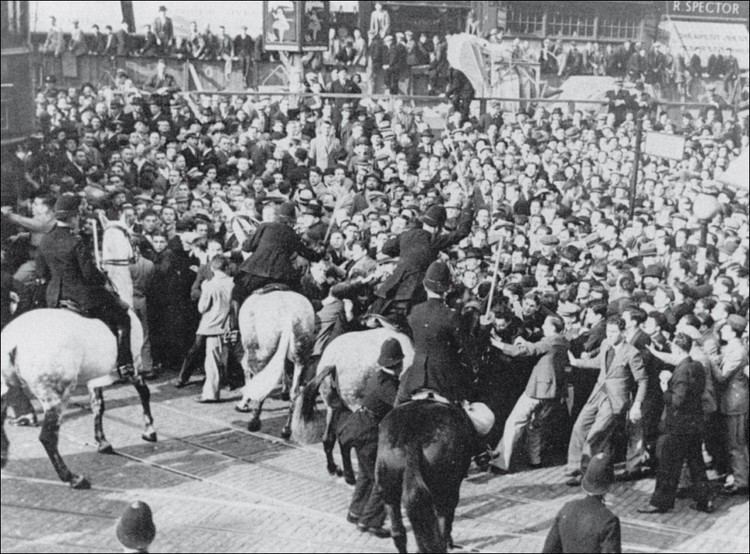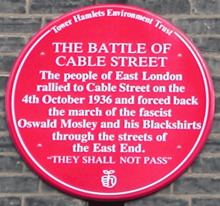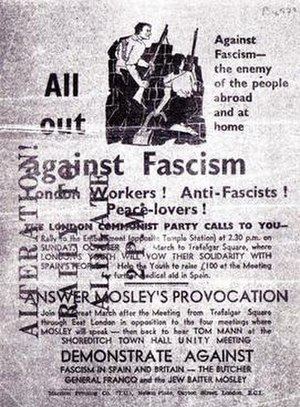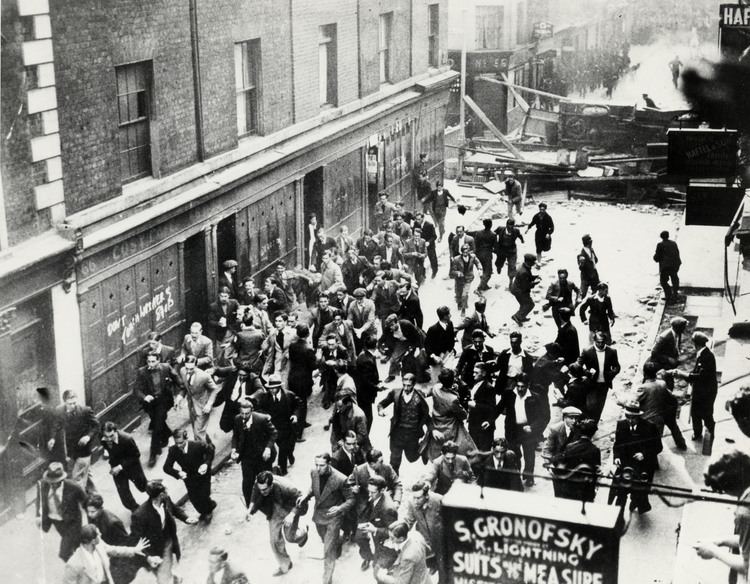3,000 20,000 Injuries ~175 Date 4 October 1936 | 20,000 6,000 Arrested ~150 Result Fascist march called off | |
 | ||
Causes Opposition to a fascist march through East London Similar Burma Campaign 1944, 1981 Brixton riot, Peasants' Revolt, Battle of Bossenden Wood, Peterloo Massacre | ||
The battle of cable street sunday 4th october 1936
The Battle of Cable Street took place on Sunday 4 October 1936 in Cable Street in the East End of London. It was a clash between the Metropolitan Police, protecting a march by members of the British Union of Fascists, led by Oswald Mosley, and various anti-fascist demonstrators, including local Jewish, Irish, socialist, anarchist and communist groups. The majority of both marchers and counter-protesters travelled into the area for this purpose. Mosley planned to send thousands of marchers dressed in uniforms styled on those of Blackshirts through the East End, which then had a large Jewish population.
Contents
- The battle of cable street sunday 4th october 1936
- Hidden london the real battle of cable street
- Background
- Events
- Aftermath
- In popular culture
- References

Hidden london the real battle of cable street
Background

The Board of Deputies of British Jews denounced the march as anti-semitic and urged Jewish people to stay away. The Communist Party of Great Britain, under the leadership of Phil Piratin, led the opposition forces. Piratin's role was widely recognised by local people. The following year, he became the first Communist to be elected to Stepney Borough Council. In 1945, he was elected as a Communist MP for Mile End.

Despite the strong likelihood of violence, the government hesitated to ban the march and a large escort of police was provided in an attempt to prevent anti-fascist protesters from disrupting the march.
Events

The anti-fascist groups built roadblocks in an attempt to prevent the march from taking place. The barricades were constructed near the junction with Christian Street, towards the west end of this long street. An estimated 20,000 anti-fascist demonstrators turned out, and were met by 6,000 police, who attempted to clear the road to permit the march of 2,000–3,000 fascists to proceed. The demonstrators fought back with sticks, rocks, chair legs and other improvised weapons. Rubbish, rotten vegetables and the contents of chamber pots were thrown at the police by women in houses along the street. After a series of running battles, Mosley agreed to abandon the march to prevent bloodshed. The BUF marchers were dispersed towards Hyde Park instead while the anti-fascists rioted with police. About 150 demonstrators were arrested, although some escaped with the help of other demonstrators. Several members of the police were arrested by demonstrators. Around 175 people were injured including police, women and children.
Aftermath

Many of the arrested demonstrators reported harsh treatment at the hands of the police. Most were charged with the minor offence of obstructing police and fined £5, but several of the leaders were found guilty of affray and sentenced to 3 months of hard labour.

The Battle of Cable Street was a major factor leading to the passage of the Public Order Act 1936, which required police consent for political marches and forbade the wearing of political uniforms in public. This is widely considered to be a significant factor in the BUF's political decline prior to World War II.
In October 2011, an article by Daniel Tilles for History Today argued that perceptions of Cable Street representing a set-back for the British Union of Fascists were mistaken:
"Contemporary records, in contrast to the romanticised recollections of those on the anti-fascist side, tell a different story. […] The demonstrators at Cable Street, and their successors in the anti-fascist movement, have understandably taken pride in their achievements that day. Yet far from signalling the beginning of the end for fascism in Britain, or even in the East End, the demonstration yielded a significant short-term boost for the BUF, and did nothing to hinder it in the longer term. True, it succeeded in demonstrating the strength of hostility to Mosley, confirming that his political ambitions would never be realised. But this had long been clear. By 1936 the BUF was a local irritant but a national irrelevance and destined to remain that way. Instead, Cable Street drew unnecessary attention and new adherents to the party. However laudable the motivation of the Jewish participants that day, the primary consequence of their actions was to make life significantly worse for their fellow Jews in the East End, with their involvement used to justify the commencement of the most intensive phase of anti-semitic activity in modern British history".
In the 1980s, a large mural depicting the battle was painted on the side of St George's Town Hall. This building was originally the vestry hall for the area and later the town hall of Stepney Borough Council. It stands in Cable Street, about 150 yards (140 m) west of Shadwell underground station. A red plaque in Dock Street commemorates the incident.
Steven Berkoff's East (1975) includes a depiction of the event; an eponymous play commemorating the events was written by Simon Blumenfeld and first performed in 1987; and in 2006 a short film was produced featuring a remembrance from a grandfather to his grandson. The 2010 revival of BBC drama Upstairs, Downstairs included several scenes of the Battle of Cable Street, although the drama wrongly suggested that Protesters and BUF actually clashed, verbally if not physically.
For the 75th Anniversary in October 2011, there were numerous events planned in East London, including music and a march, and the Cable Street Mural was restored.
